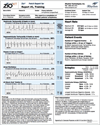Comparison of 24-hour Holter monitoring with 14-day novel adhesive patch electrocardiographic monitoring
- PMID: 24384108
- PMCID: PMC3882198
- DOI: 10.1016/j.amjmed.2013.10.003
Comparison of 24-hour Holter monitoring with 14-day novel adhesive patch electrocardiographic monitoring
Abstract
Background: Cardiac arrhythmias are remarkably common and routinely go undiagnosed because they are often transient and asymptomatic. Effective diagnosis and treatment can substantially reduce the morbidity and mortality associated with cardiac arrhythmias. The Zio Patch (iRhythm Technologies, Inc, San Francisco, Calif) is a novel, single-lead electrocardiographic (ECG), lightweight, Food and Drug Administration-cleared, continuously recording ambulatory adhesive patch monitor suitable for detecting cardiac arrhythmias in patients referred for ambulatory ECG monitoring.
Methods: A total of 146 patients referred for evaluation of cardiac arrhythmia underwent simultaneous ambulatory ECG recording with a conventional 24-hour Holter monitor and a 14-day adhesive patch monitor. The primary outcome of the study was to compare the detection arrhythmia events over total wear time for both devices. Arrhythmia events were defined as detection of any 1 of 6 arrhythmias, including supraventricular tachycardia, atrial fibrillation/flutter, pause greater than 3 seconds, atrioventricular block, ventricular tachycardia, or polymorphic ventricular tachycardia/ventricular fibrillation. McNemar's tests were used to compare the matched pairs of data from the Holter and the adhesive patch monitor.
Results: Over the total wear time of both devices, the adhesive patch monitor detected 96 arrhythmia events compared with 61 arrhythmia events by the Holter monitor (P < .001).
Conclusions: Over the total wear time of both devices, the adhesive patch monitor detected more events than the Holter monitor. Prolonged duration monitoring for detection of arrhythmia events using single-lead, less-obtrusive, adhesive-patch monitoring platforms could replace conventional Holter monitoring in patients referred for ambulatory ECG monitoring.
Trial registration: ClinicalTrials.gov NCT01559246.
Keywords: Atrial fibrillation; Cardiac arrhythmias; Electrocardiographic; Holter monitor; Zio Patch; iRhythm.
Copyright © 2014 The Authors. Published by Elsevier Inc. All rights reserved.
Conflict of interest statement
Figures
Comment in
-
Comparing 14-day adhesive patch with 24-h Holter monitoring.Future Cardiol. 2014 May;10(3):319-22. doi: 10.2217/fca.14.24. Future Cardiol. 2014. PMID: 24976467
References
-
- Jabaudon D, Sztajzel J, Sievert K, Landis T, Sztajzel R. Usefulness of ambulatory 7-day ECG monitoring for the detection of atrial fibrillation and flutter after acute stroke and transient ischemic attack. Stroke. 2004;35:1647–1651. - PubMed
-
- Hart RG. Stroke prevention in atrial fibrillation. Curr Cardiol Rep. 2000;2:51–55. - PubMed
-
- Kim MH, Johnston SS, Chu BC, Dalal MR, Schulman KL. Estimation of total incremental health care costs in patients with atrial fibrillation in the United States. Circ Cardiovasc Qual Outcomes. 2011;4:313–320. - PubMed
-
- Go AS, Mozaffarian D, Roger VL, et al. Executive summary: heart disease and stroke statistics–2013 update: a report from the American Heart Association. Circulation. 2013;127:143–152. - PubMed
-
- Reiffel JA, Schwarzberg R, Murry M. Comparison of autotriggered memory loop recorders versus standard loop recorders versus 24-hour Holter monitors for arrhythmia detection. Am J Cardiol. 2005;95:1055–1059. - PubMed
Publication types
MeSH terms
Substances
Associated data
Grants and funding
LinkOut - more resources
Full Text Sources
Other Literature Sources
Medical



